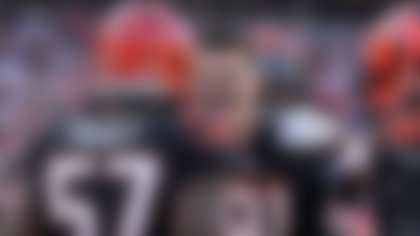When the Reese's Senior Bowl released a watch list back in August with , 48 of them were quarterbacks. Obviously, only a fraction of those signal-callers ultimately will make the final cut to play in the game at Hancock Whitney Stadium in Mobile, Alabama, on Feb. 3, 2024 (broadcast live on NFL Network at 1 p.m. ET).
So, where do things stand after a month of play? Which field generals from that original watch list have boosted their stock?
The 2024 NFL Draft class lacks elite senior quarterback prospects, but there's a plethora of intriguing Day 2 and Day 3 passers -- much like this past April's draft, in which 11 QBs were selected between Rounds 2 and 7 as teams looked for the next Brock Purdy.
At the moment, what is the QB hierarchy among 2024 Senior Bowl candidates? Below you'll find my personal top 13 -- a full baker's dozen! -- ranked in descending order by current draft status.
NOTE: Heights and weights are via school measurements.
13) Cameron Ward, Washington State (6-foot-2, 223 pounds)
Ward's throwing and scrambling skills earned him awards at Incarnate Word before he graduated to the Pac-12 in 2022, earning honorable mention all-conference honors. He whips passes into short areas, taking advantage of zone coverage, but also has just enough arm strength to stretch defenses focused on stopping Washington State's quick passing game. Ward excels when off-platform, moving within the pocket and keeping eyes downfield for targets while also possessing quickness and strength to reach the line to gain. That said, he's skittish at times when holding the ball in the pocket, which leads to pushing or slinging the ball. And he will throw into coverage when on the run instead of living for another play. He lacks elite velocity on intermediate throws, and his placement is inconsistent. Scouts may consider Ward more than just "a good college quarterback," however, if he continues to improve his ball security in the pocket, his decision-making and his clock management for the undefeated Cougars.
12) Austin Reed, Western Kentucky (6-2, 220)
Reed transferred to Western Kentucky from West Florida last year to take the prolific offense's reins from 2022 fourth-round pick Bailey Zappe. WKU's offensive line usually gives Reed a strong pocket, but he's also shown the ability to step up and wait for longer patterns to develop. He typically unloads quickly, though, to take advantage of what the defense gives him. Reed can look off safeties with his eyes, opening up back-side patterns for big gains. He has just enough arm strength to challenge defenses deep and at times impresses with his placement on sideline and seam patterns. Reed is not the most athletic quarterback, but he flashes zip on passes down the sideline or to the back of the end zone when on the move and works hard to get needed yardage on designed runs. Despite Reed not rating as elite in any particular category, don't count him out as a potential contributor on Sundays.
11) Jayden Daniels, LSU (6-4, 210)
Daniels has been in the college spotlight since his freshman year at Arizona State but still needs to improve his game before competing for an NFL starting job. He possesses active feet in the pocket and decisively fires tight spirals to either sideline in the 7-to-10-yard area. Daniels' whip arm is strong enough to hit open receivers in the intermediate game and challenge defenses vertically, throwing with arc to turn the ball over and give his receiver a chance. The lean quarterback is a real threat to break big runs with speed and agility in the open field. Daniels' stock is held back by inconsistent accuracy, however, as he showed against Arkansas last Saturday. He floated passes off-line and at the feet of his receivers, who helped Daniels' stat line by making excellent adjustments to misplaced throws.
10) Jack Plummer, Louisville (6-5, 215)
Plummer played at Purdue and Cal before coming to The Ville for his final collegiate season. He is experienced enough to recognize coverages, look off safeties and find the open man on the other side of the field. Plummer's ball placement is very good, leading receivers on slants and downfield, so they maximize their runs after the catch. He also hits his targets adeptly against zone coverage. Plummer's height and solid build belie his mobility: Not only does he routinely move within the pocket to find room to throw, but he also gets outside to find receivers and even has the ability to run for significant yardage. Plummer throws open receivers with tosses over defenses, but will also float passes where multiple defenders can attack. His game might not wow the average college football fan, but look for his draft stock to improve as more NFL teams check out his film.
9) Sam Hartman, Notre Dame (6-1 1/8, 212)
Notre Dame landed the coveted Hartman in the transfer portal after he started for four years at Wake Forest. NFL coaches will appreciate the way he efficiently operates his offense, fitting passes into tight spaces in the short game and anticipating receivers hitting windows in the middle of the field. Hartman can also hit the back-shoulder pass, fades the ball over the top against man coverage and rainbows throws to open men downfield. As a runner, he is quick and tough enough to pick up first downs when able to escape pressure and is effective finding closer targets. Hartman's at his best operating in the pocket, as his accuracy declines when on the run. But because his size and arm strength are average, many throws made under pressure fail to reach their targets. He can bounce back from hits, and he throws with anticipation outside the hashes. Hartman has a high release point.
8) Spencer Rattler, South Carolina (6-1, 217)
Rattler is a confident playmaker who offers value to any NFL team that can harness his talents. He is effective from within and outside the pocket because of his quick delivery and the pop from his arm. Rattler can find a nice rhythm whether stationary or on the move, hitting moving targets in stride with a tight spiral, and he understands where to place the ball when a defender has leverage. Though he sails passes at times, he can take something off his fastball for his larger receivers to grab jump balls. The in the 2019 recruiting class, Rattler has quick feet to escape the pocket; he keeps his eyes downfield to find targets, but he also eludes defenders when entering the open field, sliding when necessary. Rattler's slight build makes it tough for him to avoid sacks, and despite his experience, he still forces the action when feeling pressure by throwing up 50/50 balls and passing into tight spots.
7) Tyler Van Dyke, Miami-FL (6-4, 230)
Van Dyke struggled with injuries in 2022 after winning ACC Offensive Rookie of the Year honors the previous season, but he has stepped up early in 2023. He has the build of an old-school pocket passer and flashes the easy velocity to throw frozen ropes downfield and hit the hole versus Cover 2. Van Dyke can come off his primary target to hit a secondary option and has improved his ability to take speed off throws, making his receivers' lives easier. Despite his size, he escapes trouble in the pocket and keeps his eyes downfield until he needs to move his big frame as a runner. Van Dyke will float jump balls downfield at times. NFL coaches and scouts will test his ability to read coverages and complete his delivery in a tight pocket. Nevertheless, watch for him to climb draft boards if he continues to make plays while taking care of the ball during a 'Canes ACC championship chase.
6) Michael Pratt, Tulane (6-3, 220)
Pratt isn't well known outside of scouting circles, but his rep will grow in the pre-draft process. He is a four-year starter who looked great in the season-opening win against South Alabama, missed two contests with a knee injury and then with his 73rd touchdown pass in his return against Nicholls. Pratt keeps his feet active in the pocket, squaring them to second or third options before delivery. He displays natural touch on throws over the top, while his dart-throwing motion zips passes in the short and intermediate game and allows him to hit targets moving to his left and right. While not an elite athlete for the position, Pratt can slip away from pass rushers and scramble to move the chains. He must keep his eyes off the pass rush if his initial target is covered and needs to protect himself as a runner to prevent other injuries.
5) Michael Penix Jr., Washington (6-3, 213)
Penix will ramp up a potential Heisman campaign if he's able to keep up his current play against conference foes over the next few weeks. The left-hander excels when his pocket is clean. His accuracy has improved over the past year, allowing him to decisively hit his primary read among a talented trio of future NFL receivers on short, intermediate and deep throws (the last of which routinely turn over beautifully). At his best, Penix places the ball to either sideline or down the seam where only his man can get it. Though not as quick-twitch an athlete as he was before missing parts of four seasons at Indiana with knee and shoulder injuries, Penix can move and throw outside the pocket and run for first downs. His effectiveness is greatly reduced when his first option is covered, though; at times, he locates a secondary option if unbothered, but also is prone to throwing into coverage if facing real or perceived pressure.
4) Jordan Travis, Florida State (6-1, 212)
I won't bet against Travis making a name for himself in the NFL because of his mental toughness, attained through many on-field battles against top competition, and the physical toughness displayed while playing through injuries and taking hits during his four years as the Seminoles' starter. He's a playmaker and improvisor, avoiding rushers in the pocket and directing teammates downfield to deliver passes in their area. Travis can make plays from the pocket, too, getting the ball off against pressure, anticipating throws over the middle and hitting the back-shoulder or fade. He is a dangerous athlete on the run, cutting to get upfield in a hurry and being willing to do what it takes to get a first down. Travis only has adequate size and arm strength, by scouts' standards, and is not a pinpoint passer on longer throws. His desire to make plays also creates turnover chances for his opponents.
3) Joe Milton III, Tennessee (6-5, 235)
Milton transferred from Michigan after losing the starting job and then was forced to wait behind Hendon Hooker for the bulk of two seasons after suffering an injury in 2021. The Florida native has been (and will be) coveted because of his elite size and arm talent. With time and a clean pocket, he will fire lasers into tight zone windows and unleash high-arching arrows 60-to-65 yards downfield. His speed as a runner showed when he on the first play against UTSA last weekend -- and he can overpower defenders with a stiff-arm in the open field. Milton's anticipatory skills need work, however, and his longer delivery and focus on primary targets allow defenders to get to the ball despite his plus arm strength. He can be stiff in a busy pocket, short-arming or sailing makeable throws, but quarterback coaches will line up to work on these issues, given his potential.
2) Devin Leary, Kentucky (6-1, 217)
Leary has shown no ill effects from the pectoral injury that ended his time at North Carolina State last October. The ball pops from his hand; he often delivers fastballs downfield from one hash to the other sideline with a tight spiral. Leary is sturdy and calm in the pocket, efficient in his footwork and agile enough to find room to unload under pressure, whether operating from the shotgun or under center. Leary is effective on bootlegs and is a willing runner when sniffing the first-down marker or goal line. Against Vanderbilt last weekend, however, he threw two interceptions -- one after getting hit when he failed to sense a blitz, the other when he threw into coverage. Leary also threw behind receivers and sailed passes to the sideline, but he shook off those mistakes to make big throws in the win, showing he's a competitor with a short memory.
1) Bo Nix, Oregon (6-2 217)
Nix transferred from Auburn to Oregon before the 2022 season following an inconsistent career in The Plains. Ironically, he might end up as the passer with the highest floor on this list. He is in total command of the Ducks' offense, making a lot of short throws to get the ball into his playmakers' hands but also possessing a solid arm to fit passes into small windows in the red zone and launch high-arching deep balls downfield. Nix moves well within the pocket to gain time to throw, and he can take off for big gains, eluding or lowering his shoulder against defenders when needed. He still wants to make plays at times when under duress, forcing the ball between defenders and losing accuracy on short and intermediate throws. But that confidence in his abilities is what could lead Oregon to a Pac-12 title and eventually result in him winning a starting job in the NFL.













